Welding BLOG
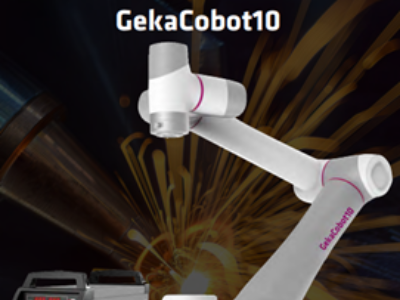
Modern Welding Automation with GekaCobot 10
Today, accelerating production lines, reducing costs, and increasing process flexibility are more important than ever. It is precisely in response to these needs that GekaCobot 10 emerges. This robotic welding system, which stands out for its quick deployment, ease of use, and flexible installation, offers businesses a modern automation experience.Graphical ProgrammingProgramming traditional welding robots has always been laborious, difficult to learn, and requires experience. However, thanks to the buttons on the robot arm and its graphical interface, GekaCobot 10Provides easy and intuitive programming,Makes learning easier,Shortens programming time.Teach-Pair Programming: True Collaboration with the RobotOne of the most impressive features of the GekaCobot 10 is its ability to create trajectories by manually dragging the robotic arm. The operator physically guides the robot to the desired position, and the system converts this into a welding program.This feature not only speeds up the process but also gives the user full control, even on complex workpieces.Safety First: Smart Stop and Collision DetectionSafety is, of course, the most critical aspect of industrial robots. The GekaCobot 10 prioritizes safety by immediately cutting off the power with an emergency stop button.In addition, thanks to its collision detection feature, the robot enters self-protection mode in the event of unexpected contact. In hazardous welding environments, this feature is a major plus for both operator and equipment safety.Flexible Operation with Five Different Oscillation PatternsNo two workpieces are the same; every industry and every production process has different welding needs. GekaCobot 10 supports five different welding oscillation patterns: linear, triangular, spiral, trapezoidal, and sinusoidal.This variety allows the system to be used comfortably in both large and small-scale production.Power MIG GPS 5000-R: The Powerful Heart of the SystemThe Power MIG GPS 5000-R welding machine, which works perfectly with GekaCobot, creates excellent welds with different welding modes such as Dual MIG, Pulse MIG, and CV MIG. Thanks to the perfect communication compatibility between GekaCobot 10 and Power MIG GPS 5000-R, data is transmited smoothly without being affected by electromagnetic interference in the environment. This duo works reliably in harsh industrial conditions.PortabilityGekaCobot 10 weighs only 40 kg!The light weight of the GekaCobot 10 stands out as its most important feature that sets it apart from industrial robots. It can be easily transported and set up at different welding stations and quickly put into operation.It is suitable for use on welding tables. It makes your welding tasks easy and enjoyable with welding tables and fixture solutions. Please contact our sales team for welding tables and fixture solutions.Click here for the GekaCobot10 General PDF.Click here for the GekaCobot10 Detailed PDF.
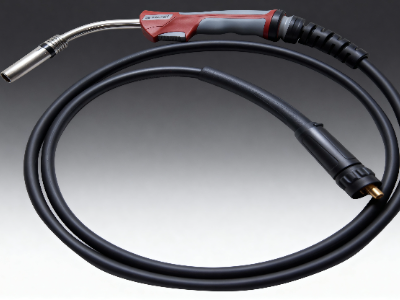
How To Choose a Torch?
How many types of welding torches are there?The torch, which delivers the protective gas and weld metal to the welded area, enables the welder to weld. Torch types also vary according to the welding machine and material. Torches are divided into three types: MIG-MAG type torches, which we call gas metal arc torches; TIG torches used in TIG welding machines and plasma cutting torches.The Machine and the Torch Should Be CompatibleWhen we look at gas metal arc welding torches, the machine and the torch need to have the same amperage. For example, for a 500-amp machine, a torch with a 500-amp carrying capacity should be used. Having a very long torch is also a disadvantage for the welder because transmission problems can occur. The welding torch should be as short as possible whenever possible.How It Is Used Affects the Life of the TorchIncreasing the lifetime is a factor also in the hands of the welder. In the field, welding torches are the parts most exposed to heat. It is the part that is exposed to the most heat right in front of the arc and the bathroom. There are some common usage mistakes that we frequently come across. For example, instead of pulling the machine to move it, the machine is pulled by holding the torch. This damages the connection parts of the torch. Or a piece can fall on the parts of the torch that are on the ground, or it can be stepped on. There should be a place to hang the torch after the welding work is finished. It is possible to increase the service life by cleaning the burrs that splash into the nozzle during welding, or even by spraying a chemical spray. There are Three Consumable Materials In MIG/MAG torches used in gas metal arc welding, the part most exposed to heat is the nozzle. It is made of copper, and some versions are chrome-plated. Just behind the it, there is a component called the contact tip, and behind that is the diffuser, which distributes the protective gas during welding. And right after that, there is a tip holder, which is also made of copper. These are motly the products that we call pure materials, and since the contact tip is the part most exposed to heat, it is replaced at regular intervals. In these, materials containing zirconium are more resistant to abrasion and have a longer service life.It Is Possible to Use LongerFor example, the service life of a contact tip varies depending on its application and the amperage used. However, careful handling by the welder can significantly extend the lifespan of such components. For instance, if burrs stuck to the nozzle is removed by hitting it, the nozzle may become bent, reducing its service life. In contrast, when the nozzle is cleaned using a hand tool, no damage is caused to the part.Types of Torches According to Cooling MethodWater-cooled torches circulate water from the machine's connected cooling unit to the neck of the torch. This water circulation, passing through the torch neck and trigger handle, helps prevent the torch from overheating during welding. In this way, the torch is effectively cooled by water.Air cooling, on the other hand, means that the torch is cooled by the surrounding air. These cooling methods apply not only to TIG welding torches but also to MIG/MAG welding torches.
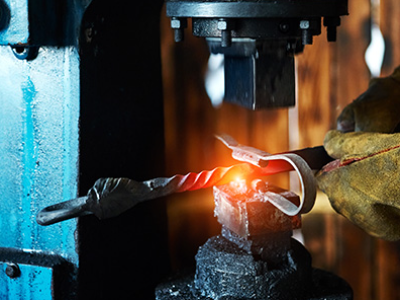
Welding of Tool Steels
What are Tool Steels, What are their Types?Tool steels are steels with high hardness, toughness or high temperature resistance used in shaping a wide variety of materials by processes such as machining, cutting, drilling, pressing, casting, and forging. It is divided into four groups as cold work tool steels, hot work tool steels, plastic tool steels, and high-speed tool steels:Cold Work Tool Steels: Tool steels used in applications below 200 °C are in this group. Abrasion wear is often encountered on tools. The hard wear resistant carbides required for steels are usually provided with chromium, molybdenum, vanadium, and tungsten. Threading tools, scissor knives, cutting tools, bolt head forging tools, and deep drawing tools can be given as examples to this group.Hot Work Tool Steels: They are tool steels used at temperatures above 200 °C. High temperature resistance is provided by elements such as molybdenum, tungsten, and vanadium. Forging dies, forging tools, casting dies, continuous casting rolls, hot cutting blades, and hammering dies, can be given as examples for hot work tool steels.High Speed Tool Steels: They are tool steels that can remove chips by maintaining their hardness even at high temperatures, in a way that the end of the tool will be hot. In addition to adding elements such as tungsten, molybdenum, and vanadium chromium to the material, hot rolling and special heat treatment suitable for the material should be applied for homogeneous distribution of carbides in order to give the material the desired strength at high temperatures. Cutting and drilling tools that maintain their hardness even at 600 °C can be given as an example for this group.Plastic Work Tool Steels: They are generally used in shaping plastics by injection, extrusion, blowing, and pressing techniques. Compared to other tool steels, they have higher corrosion resistance, polishability, and patterning capabilities. They contain alloying elements such as chromium, manganese, molybdenum, nickel, vanadium, and aluminum.How to Perform the Welding of Tool Steels?Steels containing more than 0.2 percent carbon have low welding capability. Welding of tool steels with a carbon ratio of 0.8 - 1.5% is a very difficult process due to the high risk of cracking. Hence, repair and maintenance welding are applied in tool steels rather than joining. Welding is mainly applied in processes such as hard facing applications of worn surfaces and repair of cracks, except for the joint welds made for the revision of the mold due to the design change and the obligation of combining the prepared parts into a mold.Preliminary Preparation: It is important to control and prepare beforehand the surface of the part before the welding application of the tool steels. Surface cleanliness should be checked and factors such as oil and dirt have to be cleaned before application. Whether there are cracks on the surface of the part or not should be examined visually or with a penetrant test and, if there is any crack formation, it must in any case be cleaned by intervening before welding. “U” welding end should be preferred in welding end design.Preheat: It is important to preheat before welding. Preheating reduces the risk of warping and cracking by reducing the cooling rate. The preheating temperature should be below the tempering temperature of the tool steel and 50-100 °C above the martensitic transformation temperature of the weld metal to be used. During welding, the weld zone should always be kept within this temperature range. Preheating temperature is recommended as 200-300 °C for tool steels made of low alloy steels, 300-400 °C for tool steels made of high alloy steels, 400-600 °C for hot work tool steels, and 400-500 °C for high-speed tool steels. Heating should be slow and homogeneous. The recommended heating rate is 50 °C/hour.Welding Application and Selection of the Filler Material In the welding of tool steels, attempts must be made to keep the heat input low. Welding methods with low heat input such as TIG should be preferred, and if electric arc welding is to be applied, electrodes with as small diameter as possible should be used. It is recommended to weld by using minimum voltage and current parameters in all welding methods.After each pass, the slag cleaning should be performed carefully and lightly hammered while the seam is hot. Slow cooling of the seam after welding is important.Sharp corners and edges should not be allowed to form after welding. Crater formation should be prevented at the end of welding.In hard filling applications that require multiple passes, the number of passes should not exceed 3. Buffer welding can be applied between the base material and the hard filling application.GeKatec 229 SUPER electrodes can be used for buffer welding or GeKa Elox SG 312 MIG or TIG wires for gas metal arc welding applications.In tool steel welding applications, the chemical composition of the tool steel, the heat treatment condition, and the desired hardness value if hard filling is to be applied, play an important role in the selection of the filling material. In normalized tool steels, the chemical composition of the filler material is desired to be the same as that of the tool steel, while in hardened tool steels, the properties such as hardness and temperature resistance of the weld metal are expected to be similar.While GekaTec Tool 60 electrode is used in hard filling applications of cold work tool steels, very satisfactory results are obtained with GeKatec Tool 55 SG and GeKatec Tool 60 SG arc welding wires and rods. The welding filler of GekaTec Tool 60 electrode and GeKatec Tool 60 SG arc welding wires and rods are in the structure of speed steel and are also preferred in hard filling applications of high-speed steels. GeKatec Tool 45 SG welding wire, which is used in filler welding of hot work tool steels, provides very good resistance to abrasion and impact at high temperatures.
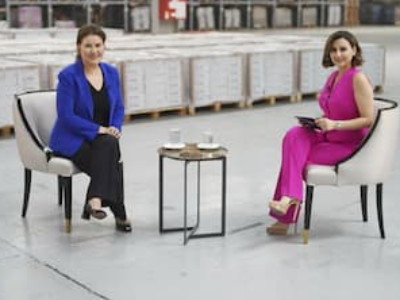
Hülya Gedik Discusses Industry and Economic Agenda in Media and Academia
Our Chairwoman of the Board at Gedik Holding, Hülya Gedik, participated in an interview broadcast on CNBC-e at our Gedik Kaynak production facility in Hendek. The program was moderated by Şafak Tükle.During the discussion, current developments in the industrial and economic agenda were addressed. Hülya Gedik shared her insights on global trade balances, Turkey’s competitiveness, and the future of the industry. She also provided perspectives on the operations within our production facilities and Gedik’s strong position in the sector.Bloomberg HT “60 Minutes”: The Impact of International Trade on TurkeyOn September 25, Hülya Gedik appeared on Bloomberg HT’s “60 Minutes” program as the Chairperson of the DEİK Turkey-India Business Council. The discussion focused on the potential effects of the free trade agreement between the European Union and India on Turkey.Hülya Gedik emphasized the significance of this development for both the economy and industry, sharing her views on how changes in global trade dynamics could influence Turkey’s competitiveness and the future of its industrial sectors.Meeting with Students at SUBÜ: Sharing Knowledge and ExperienceOur Chairwoman of the Board, Hülya Gedik, met with the academic staff at Sakarya University of Applied Sciences (SUBÜ) upon the invitation of the Career Center.During the event, she shared her knowledge and experiences with students in an engaging talk aimed at inspiring their career journeys. Hülya Gedik expressed her gratitude to Rector Prof. Dr. Mehmet Sarıbıyık and the Career Center team for organizing the program.

GEDIQ: Gedik Kaynak’s Next-Generation Digital Assistant
Quick, Accurate, and Reliable Access to InformationThe GEDIQ Artificial Intelligence Assistant has been developed to ensure that users can access the information they need quickly, accurately, and reliably. With its comprehensive data structure, it simplifies information access for both individual users and business partners.Easy Access to Product InformationGEDIQ provides detailed descriptions of Gedik Kaynak products. It delivers all items featured in the product catalogs along with their technical details, enabling users to access all necessary information about a product from a single point.Comprehensive Information About Gedik Holding and Group CompaniesThe assistant is not limited to product information—it also shares extensive content about the companies under the Gedik Holding umbrella. This allows users to access up-to-date information about the activities and corporate structure of the Gedik Group.Sales Network and Contact InformationGEDIQ also provides information about the sales network located in Turkey and different regions of the world. Users can easily find the contact details of their regional sales managers and access the dealer networks specific to their location.A New Era in Digital TransformationWith GEDIQ, Gedik Kaynak has taken another user-focused step by digitalizing the process of information access. This AI-powered assistant stands as a tangible example of the company’s digital transformation vision, representing innovation, accessibility, and technological advancement.
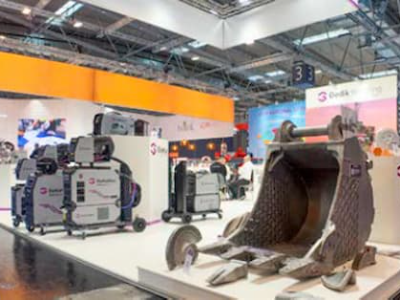
Gedik’s Innovative Solutions at Schweissen & Schneiden 2025 in Germany
SCHWEISSEN & SCHNEIDEN 2025 was held from September 15–19 in Essen, Germany. As one of the most prestigious meeting points for welding and cutting technologies, the fair brought together industry professionals from all around the world. Gedik took its place at this major event, showcasing its innovative solutions and wide range of products.International Collaborations and Technology PresentationThroughout the exhibition, visitors were introduced to the latest advancements in welding technologies. At the same time, international collaborations were strengthened, and valuable insights about the future of the industry were shared. This event provided a significant opportunity for Gedik to demonstrate its innovative approach and global vision.62 Years of Experience and a Global VisionWith 62 years of experience and industry expertise, Gedik continues to showcase its leadership and innovative solutions in welding technologies on international platforms. The company’s global vision reinforces its goal of being a pioneer in welding and cutting technologies.
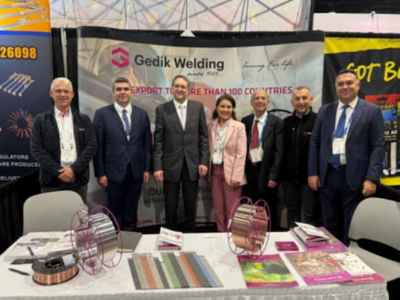
Gedik Kaynak Meets International Visitors at the FABTECH Fair in the United States
Gedik Kaynak showcased its latest welding technologies and innovative solutions to international visitors at the FABTECH Fair held in Chicago, USA. Throughout the event, the company attracted great interest from both industry professionals and participants from various countries. Visitors had the opportunity to receive detailed information about the displayed products and technologies.Turkey’s Expertise Stands Out in International VisitDuring the event, the Consul General of the Republic of Turkey in Chicago, Mr. Tahir Bora Atatanır, and the Commercial Attaché, Dr. Ahmet Samet Tekoğlu, visited the Gedik Kaynak booth. This visit not only strengthened Gedik Kaynak’s position on the international stage but also highlighted Turkey’s expertise in welding technologies at a global level.Gedik Kaynak’s Global VisionIn line with its global vision, Gedik Kaynak will continue to bring the latest advancements in welding technologies to professionals around the world. By maintaining its focus on innovative solutions that make a difference in the industry, the company continues to reinforce its leadership goal in the international market.
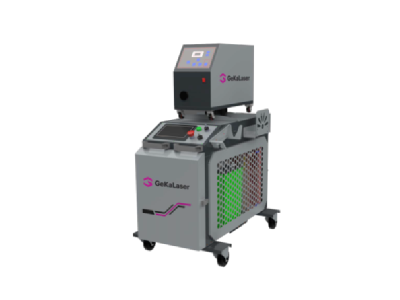
Locally Produced GeKaLaser Laser Welding Machines Achieve Their First Sales
The M Series GeKaLaser laser welding machines, developed by our Machinery R&D team, have successfully completed their trial production phase and achieved their first sales. This development holds great significance both for our company and for the Turkish manufacturing industry, as it represents a strong step forward in delivering globally competitive solutions.Advantages of GeKaLaser Laser Welding MachinesThe new generation of laser welding machines stands out with its high-precision laser beam, minimal heat input, and low deformation rate. As a result, they provide much higher quality and more efficient outcomes compared to conventional welding methods.Their high speed and superior seam quality, especially in joining thin sheets and delicate components, make these machines an ideal solution for various industries.Local Production and Competitive Price AdvantageBeing locally manufactured, GeKaLaser machines are offered to the market at competitive prices, reinforcing our brand’s leadership in this field. Developed in Turkey, this technology positions both our company and the Turkish manufacturing industry in a strong and competitive place globally, thanks to its excellence in quality and efficiency.

Innovative Product Launches and Modern Packaging Designs
As Gedik Kaynak, we take pride in being a pioneering brand in the industry since 1963. With our innovative approach and strong infrastructure, we continuously enhance both our product portfolio and brand value.Seamless Cored Wire Launch: A First in TurkeyAs a brand that not only keeps pace with technological advancements but also aims to lead them, we have achieved yet another first in the industry. Known as the “Seamless Cored Welding Wire,” this state-of-the-art product stands out as the first domestically produced seamless cored wire manufactured in Turkey at our advanced production facilities.This achievement positions us strongly not only in the local market but also on the international stage. As one of the few manufacturers worldwide capable of producing this high-tech product, we see it as a tangible reflection of our production capacity and engineering excellence.International Launch in GermanyWe introduced our new product at Schweissen & Schneiden in Germany—one of the world’s most prestigious trade fairs for welding technologies. This significant milestone allowed us to showcase our innovation power on a global scale.With its cutting-edge features, the seamless cored wire adds value to our product range while setting us apart from the competition.Modern and Strong Packaging DesignAlongside the introduction of our new product, we also renewed our packaging designs. Our newly developed modern and robust packaging concept emphasizes the quality and advantages of our products, enhancing our brand’s competitiveness.Visually and functionally improved, this design not only enhances user experience but also reinforces our brand’s strong presence in the industry.Steps Shaping the FutureAs Gedik Kaynak, we remain determined to bring more “firsts” to the industry and to offer innovative solutions. Our seamless cored wire launch and packaging design projects aim not only to meet today’s needs but also to shape the industrial standards of the future. With our innovative vision, we will continue to make a difference in global competition and lead the industry forward.
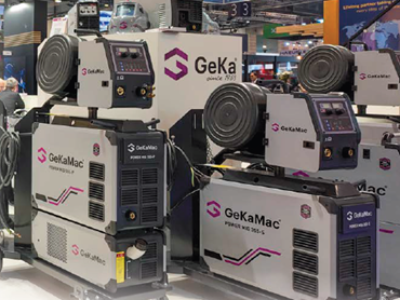
As Gedik Kaynak, We Have Added Another Innovation that Strengthens Our Leading Position in the Industry
By renewing the design concept of our welding machines product group, we are presenting our users with a more modern, powerful, and technological look.Modern and Technological Design ApproachThe designs of our welding machines, produced under the Gekamac brand, have been transformed into a more contemporary and dynamic structure. These renewed designs not only highlight the strong character of our products more clearly but also aim to enhance the user experience.Our new design launch was successfully carried out at the Schweissen & Schneiden fair held in Germany. This important step has been a strategic development that increased the international visibility of our Gekamac brand.Strong Appearance, Expanding Product RangeOur new designs not only strengthen our brand visually but also expand our product diversity. Our welding machines now feature:• A more modern and powerful appearance,• Enhanced durability,• Technological advantages that bring innovation to the industry,• A user-friendly structure equipped with advanced features.At the same time, our efforts to expand our product range continue with determination. This process enables us to provide stronger solutions to the evolving needs of the industry.As Gedik Kaynak, we continue to lead the sector with our innovative production approach and strong brand identity. The new design of Gekamac welding machines—with its modern look and high performance—will not only enhance our brand’s competitiveness but also provide our users with an advanced experience.This step is a reflection of our strong vision that unites technology with aesthetics.
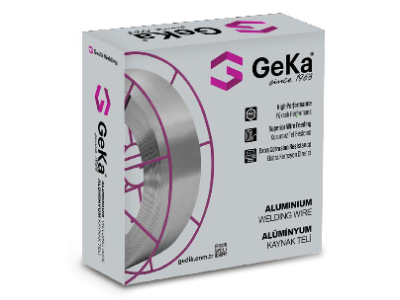
A New Step in Local Production: Aluminum Wire and Modern Packaging Design
As Gedik Kaynak, we are taking innovative steps to further strengthen our strong position in the industry. While our local production efforts in the aluminum wire product group are rapidly progressing, we have simultaneously completed our modern packaging designs. This development reflects both our commitment to local production and the renewed identity of our brand.Product Range Strengthened by Local ProductionBy focusing on local production in aluminum wire products, we are offering strong and sustainable solutions to the industry. This important step in our production process once again demonstrates our brand’s technological competence and commitment to quality.Along with the new packaging designs, we aim to increase the visibility of our products in the market. This change supports the modernization of our brand’s structure while also enhancing the user experience.New Packaging Design Highlighted with the GeKa BrandThe new packaging designs of our GeKa brand have been renewed to strengthen its visual identity and to communicate the product advantages more clearly. In the design:• The GeKa logo and product visuals were brought to the forefront,• The benefits offered to users were featured directly on the packaging,• A modern and strong brand image was created.With this innovative design, our brand and products will become more visible in the market, increasing our brand recognition. As the stocks of the old packaging designs are depleted, our newly designed products will meet our customers.Continuity in Packaging DesignsWe have also completed the packaging designs for our wire and electrode product groups, further strengthening the visual integrity of our brand. In our new designs, the GeKa logo has been made more prominent, and the advantages of the products have been directly reflected on the packaging.This approach sets a new precedent in the industry while increasing the visibility of our brand. Our goal is to ensure that the GeKa brand achieves a stronger position in the market and that the superior features of our products are clearly highlighted to users.Our Vision for the FutureAs Gedik Kaynak, we continue to add value to the industry by combining our innovative production processes with our modern design approach. With our local production power and modern packaging designs, we aim to further strengthen our brand’s strong position in the market.

GeKa Seamless Flux Cored Wires
What is Seamless Flux Cored Wire?Flux Cored Wires can be produced in two different ways as seamed and seamless. Seamed cored wires are produced by first rolling/forming the steel strip into a "U" shape in the forming machine as in the production of welded pipes and then putting the powder-mix “core” into it and then closing it into a pipe form and drawing it. On the other hand, seamless cored wires are produced by filling the core into a previously formed steel pipe and drawing it to the desired end-product diameter. With the advancement of technology, a faster and more efficient seamless cored wire production process has been developed. In this method, the core is filled into the U-shaped strip as in the production of seamed cored wires, then the strip is rolled into a circular form and the edges are welded seamlessly with a laser beam. Since there is no gap in the seamless cored wires, contrary to the seamed cored wires, the risk of moisture absorption of the core is automatically eliminated. TYPES OF FLUXCORED WELDING WIREWhat are the advantages of Seamless Cored Wire?In Seamless Cored Wires, the risk of hydrogen-induced cracks is minimized as the seamless design prevents re-absorption of moisture. Since seamless cored wires have very low moisture contents in the core and it is virtually impossible to pick up moisture under normal storage and operation conditions, the need for special vacuum packaging is eliminated.Another advantage of Seamless Cored Wires is the possibility of copper coating. Copper coating protects the wire surface against corrosion, prevents friction in the passage through the liner and contact tip during welding and greatly enhances wire feedability. Finally, thanks to the copper coating, the electrical resistance between the wire and the contact tip is considerably low, resulting in a much more stable arc, cooler contact tip and nozzle, thus in turn, reducing nozzle wear and cooling requirements.Since the production of Laser Welded Seamless Flux Cored Wire requires a distinct technology, knowledge, know-how and experience, the number of companies in the world that can offer products with premium quality still is very limited. Gedik Welding is proud to be the only leading and pioneering company in this field in Turkey and has taken its prestigious position in global competition to a higher level.
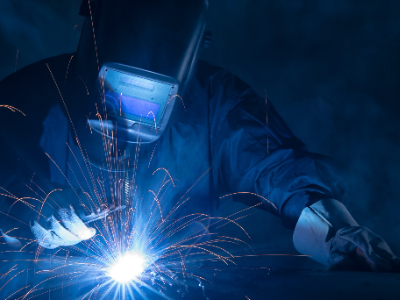
GeKaWeldSim Realistic Welding Experience
GeKaWeldSim Welding simulators based on Virtual or Augmented reality (VR or AR) system are systems that provide an extremely close to reality welding experience consisting of welding machine, welding mask, welding table, welding electrode holders in original shapes and weights, MIG / MAG and TIG torches. The systems, which can simulate the welds made in different welding methods one-to-one, detect and analyze the errors made during welding, are especially preferred for training purposes in educational institutions and industrial enterprises that want to train welders.Since there is no consumption of consumables and main materials to be welded in welding simulators, training costs are minimized, while occupational safety risks that may occur during training are eliminated.With Welding Simulators, Shielded Metal Arc Welding (SMAW), Gas Metal Arc Welding (GMAW-GTAW), Flux Cored Arc Welding (FCAW) processes can be simulated in full detail. Parameters such as feed speed, feed angle, working angle, arc length distance, position, distance between the contact nozzle and the workpiece can be monitored live on the analysis screen, while welding defects such as insufficient penetration, slag inclusion, burning groove, porosity, poor drop placement, excessive convexity / concavity, incorrect weld size, excessive spatter can be monitored and reported together with their location on the seam, providing a detailed performance analysis.
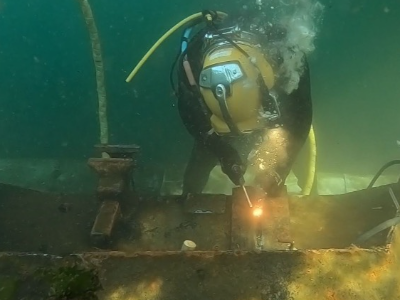
Smart choice for Underwater
SMART CHOICE FOR UNDERWATER In recent years, more than 50 percent of developed oil deposits and natural gas pipelines are located under the sea, increasing offshore development to develop and exploit mineral resources. Underwater welding plays a special role in the maintenance and repair of modern offshore installations, pipelines and ships. The large amount of underwater structures used in oil and gas production and the increasing intensity of maritime transportation constitute the technological cornerstone of economic development and strategic issues. Gedik Welding has produced Turkey's first domestic underwater welding electrodes as a product of its long years of knowledge and experience in the welding industry. These electrodes have been designed and formulated to produce welding metal with unrivaled, high-performance standards in the field for structural underwater wet welding in all sectors, including offshore oil and gas pipelines, commercial vessels, coastal industries and nuclear facilities. It is available for assembly and repair welding in water depths up to 20 m for offshore and harbor construction, shipbuilding and underwater engineering.Meets Class A Source CriteriaMetal arc welding with covered electrodes with rutile character is the most common underwater welding method used. GeKa UW E7014 is a rutile covered electrode developed for underwater welding with a waterproof coating. AWS A5.35/A5.35M: 2015 standard requirement and AWS D3.6M:2017 Class A quality level. A premium underwater welding electrode with excellent properties that fulfills the "Class A" welding criterion in all positions for both inside fillet and butt welds of pipe and sheet joints according to the international AWS D3.6M:2017 standard. The electrode consists of a specially formulated high efficiency rutile coating that offers a continuous weld seam.Waterproof CoatingThe electrode cover needs to be protected from the water environment by a waterproof coating. In order for underwater welding electrodes to provide high quality weld metal, the waterproof coating is expected to prevent moisture from penetrating the electrode cover, while at the same time allowing it to burn without undue interference with metal transfer. The waterproof coating protects the electrode cover from water and moisture. It also provides the highest level of protection against physical damage to the electrodes, while providing electrical protection for the diver underwater. The soft breakable electrode tip prevents contact of the electrode cover with water, even if it has to remain underwater until welding. Thus, the electrode continues to retain its rutile cover properties during welding. GeKa UW E7014 electrodes are comfortable to use in both fresh and salt water, perform exceptionally well in any position and are specially designed to produce high quality welds at different depths on a variety of carbon steels. With its outstanding user-friendly features and enabling long working times underwater, GeKa UW E7014 is destined to become the electrode of choice for professional welders worldwide. More stable burning and less spatter during welding than other underwater welding electrodes. Easy slag cleaning for the welder. The electrode is easy to re-ignite and the molten metal deposition rate is highly efficient and excellent seam appearance is achieved.Effective and fast solutionInternational interests to develop and exploit the oceans and their mineral resources have allowed the development of offshore gas and oil fields, offshore construction and hence underwater resource development. Underwater welding has been used for construction and maintenance work, but mostly for temporary repair work. Failure of parts underwater can be caused by collisions of ships, unexpected accidents or corrosion. Underwater welding is an effective and fast solution as it can be done immediately after the accident without the need to remove the structure from the water. Underwater welding is also applied in the manufacture of large ships and offshore structures that do not fit into the dock. Underwater welding is also applied to the installation and maintenance of pipelines. GeKa UW E7014 electrodes are available in Ø3,20 and Ø4,00mm. Welding should be performed in accordance with the parameters specified in the catalog.Protective equipment and diving equipment in accordance with occupational safety rules must be used before all stages of use. The most important issue in underwater welding is the availability of welding and welding safety equipment. Due to the high safety risks, great importance and responsibility for carrying out these activities lies with trained human resources, including surface divers and the organizational team. GeKa UW E7014 electrodes are designed to be used in all positions, even for less experienced divers. At the same time, in the hands of more experienced divers, welding can be performed allowing a friendly, controllable arc characteristic. Welding pliers and torches should be as insulating as possible, allowing as little current to escape as possible. Attention should be paid to the angle and height of the grip in welding due to the effect of pressure under water. Attention should be paid to the applicability and accuracy of welding positions.
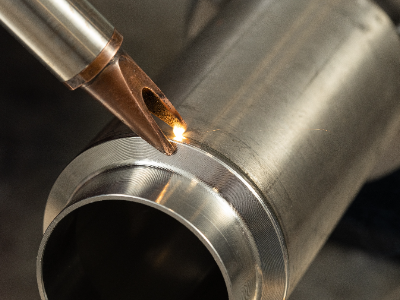
Laser Welding Technology: Fast, Efficient and Environmentally Friendly
Fast and Efficient: The Power of Laser Welding Technology!Laser welding technology, which is rapidly increasing in use due to its fast and efficient compared to conventional welding methods, enables welding and cutting with low heat input and minimal deformation.Easy to Use, No Professional Knowledge Required: Laser Welding AdvantagesIt is very easy to use and eliminates the need to be an experienced welder as it does not require professional knowledge and experience to weld. The fact that it is much faster than traditional welding methods is one of its salient features.Environmentally Friendly and Energy Efficient: The Environmental Contribution of Laser WeldingThe laser's photoelectric conversion efficiency results in up to 30% less energy consumption and is therefore environmentally friendly. Thanks to the very low heat input in the laser welding process, penetrating, deformation-free and resistant welds can be obtained even in the thinnest materials.Fiber laser welding machines, which are available in our product range with 3 different power options as GeKaLaser 1000, GeKaLaser 1500, GeKaLaser 2000, offer the possibility of cutting and cleaning as well as joining various materials such as unalloyed steel, stainless steel, aluminum, copper, brass with the 3IN1 feature, while eliminating additional labor costs as there is no need for leveling and grinding processes after welding with continuous welding mode.Precise Solutions for Different SectorsOur GeKaLaser Laser Welding machines offer precise solutions in many applications and sectors such as industrial kitchen manufacturing, furniture shelf and scaffolding manufacturing, machinery manufacturing, railing and window manufacturing, advertising and lighting sector, automotive, medical, aviation sector.
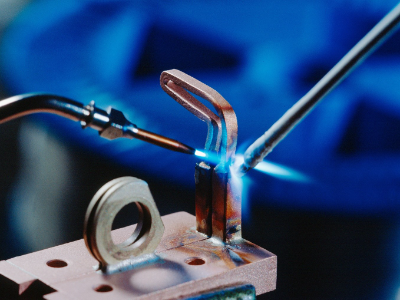
Brazing with Oxy Gas Flame
What is Brazing, How Is It Done?The joining of different or same type metals with a heat source using an additional solder alloy that melts above 450 °C is called brazing. The joining process takes place with the metallurgical bond formed by the transfer of atoms called diffusion between the additive metal and the metals to be combined.Where is Brazing Used?The brazing process allows the economical joining of different types of materials with different cross-sectional thicknesses. Therefore, it is preferred in many sectors such as automotive, white goods, aviation and space industry, heating-ventilation, gas armatures production, food sector, and medicine sector. It is also widely used in pipe connections carrying oil, air and fuel where impermeability is important.In brazing joints, in the metals to be joined, unlike welding, melting does not occur. Since there is no significant change in the crystal structure of the material, the homogeneity of the internal structure of the metal is preserved. As the brazing temperature is above 450 °C and lower than the melting temperatures of the soldered metals, deformations caused by high temperatures do not occur in the welded joints.The molten metal solidifies by spreading between the parts to be brazed by capillary action (with capillary tube forces). It is recommended that in order to take advantage of the capillary effect, the spacing of the parts to be brazed should be set between 0.05-0.5 mm. In larger soldering intervals, the capillary effect cannot be benefited from. All elements that will prevent the attachment and flow of the additive metal between the material surfaces to be joined should be removed before the brazing process. Elements such as oil, rust, and paint on the material surface cleaned by brush, sandpaper or suitable chemical methods should be taken to the brazing process without waiting for too long.When the brazing process of the surface-cleaned materials is started, oxide formation starts on the surfaces due to the heat. Fluxes are used to prevent and clean this oxide formation. Fluxes melt 50 °C before the operating temperature, increasing the fluidity of the additive metal while cleaning the oxide.The selection of fluxes that prepare the melt joint zone for brazing before the filler metal is made according to the filler metal. While GeKaTec FLUX F-SH1 fluxes are used for the use of silver alloy brazing rods, it will be appropriate that GeKaTec FLUX F-LH1 fluxes are preferred for brazing aluminum and its alloys. The selection of these related fluxes is determined by the melting temperatures of the materials to be brazed.Self-flux coated brazing rods such as GeKaTec L-Ag20 FC or GeKaTec L-Ag40 FC provide convenience to the user in practice. In addition, since GeKaTec S5 brazing rods, which are frequently preferred, have very high fluidity, they can be used without flux in joining copper to copper.In the selection of the additive metal, it is desired that the melting point of the main metal be at least 200 °C higher than the melting point of the additive metal. Color compatibility can also appear to us as an important criterion in the selection of additional filler materials that are expected to match the mechanical properties of the main material to be brazed.Flame Types in Oxy-Gas Flame BrazingNeutral Flame: It is the type of flame in which the ratios of combustible gas (acetylene) and oxygen are equal. It is generally preferred for brazing metals such as steel and copper.Carburizing Flame: Flames with high flammable gas ratio are called carburizing flames. Its burning is calmer. Its flame cone is longer than normal flame. It is preferred in brazing of cast irons, in order to prevent oxygen content in brazing of aluminum and its alloys, the surface of which is easily oxidized.Oxidizing Flame: It is the type of flame with high oxygen ratio. Its burning is harsh. The highest temperature values are reached in this type of flame. It is used for brazing brass having zinc evaporation problem.
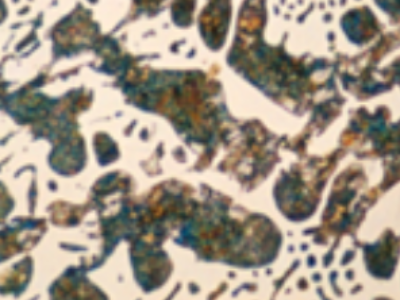
Advanced Casting Technologies/Chill Problem
Every engineer working in foundries has encountered the problem of chill at some point in their career. This problem, which occurs particularly in thin sections, is often associated with high cooling rates and/or insufficient inoculation. For this reason, foundries dealing with chill problems usually try to find a solution by increasing the amount of inoculant used or by experimenting with different inoculant materials. Although this may seem like the first solution that comes to mind, there may be a different underlying cause behind the formation of chill.THERE MAY BE A DİFFERENT REASON FOR CHİLL PROBLEM THAN YOU THİNK.This structure, which we call “chill” (English: chill), is actually a carbide structure known in metallurgy terminology as white cast iron. When conditions suitable for graphite decomposition are not provided during the eutectic transformation, the carbon dissolved in the liquid cannot separate as a separate phase in the form of graphite. As a natural consequence, carbon atoms remain dissolved in the liquid metal. During eutectic solidification, the carbon cannot be expelled from the liquid and solidifies, resulting in the hard and brittle structure we call carbide (chill).When most foundries encounter the problem of chill, they may increase the amount of inoculant they use to solve the problem, based on the scenario described above. Although this may seem like the first solution that comes to mind, there may be a different underlying cause for the chill. To identify the true cause of chill formation and determine the correct solution, examining the microstructure of the formed carbide under a microscope often provides valuable insights.For example, if the formation of chill is really due to high cooling rates in thin sections or a problem related to overheating, then we see that the carbide has formed in a ledeburite structure (left image). When we examine this structure under a microscope, we see dark-colored islands within a continuous carbide phase that appears light in color.Carbides formed in cast iron can also be seen under a microscope in the form of thin rods. These carbides, which actually precipitate in plate-like structures, appear as rods in a two-dimensional image taken through a cross-section. If the chill structure appears as rod-like carbides under a microscope, it can be concluded that too much Mg was used in the spheroidization process or that the amount of silicon, which is a graphitizing agent, was insufficient. Since magnesium is an element that tends to form compounds with both oxygen and sulfur, when an excessive amount of Mg is used, we observe that the oxygen and sulfur levels in the liquid drop to very low levels. As explained in various articles and lectures we have published on inoculation, a certain amount of oxygen and sulfur must be present in the liquid for the inoculant added to the liquid metal to function properly. When oxygen and sulfur levels drop to very low levels, graphite decomposition cannot be achieved, resulting in the inevitable formation of scale.In the case of reverse chill, we see that the carbide particles exhibit a similar structure resembling a rod. This situation, which is observed mainly in large and circular sections, occurs due to the accumulation of carbide-forming elements in the liquid and their clustering in the middle section, resulting in a strong carbide-forming effect in this area.Although chill is generally associated with rapid cooling and/or insufficient inoculation, we can see that this problem can also arise due to different causes. As explained above, a simple metallographic analysis allows us to identify the true cause of the problem and the correct solution. In other words, instead of relying on memorized methods, taking the time to examine the issue more closely enables us to easily identify the root cause and the appropriate solution.
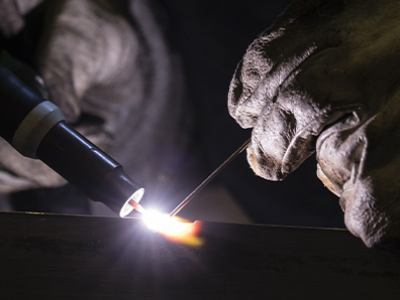
Tungsten Electrode Selection
What is Tungsten Electrode?Tungsten electrodes, which ensure the welding process on the workpiece by carrying the current required for arc formation, stand out among the components in TIG welding. The selection of tungsten electrodes, which vary in current carrying capacity, arc characteristics, service life, re-ignition performance with different alloys, is important for welding performance.Where Is Tungsten Electrode Used?Tungsten electrodes, which are indispensable components of TIG welding, can be used for TIG welding of unalloyed and low alloyed materials, stainless and aluminum, depending on their types. Parameters such as the type of material to be welded and the type of current to be used in welding are important in their selection.Tungsten Electrode Types and their PropertiesGreen (Pure) Tungsten ElectrodesWhile unalloyed, pure tungsten electrodes have advantages over other types of tungsten electrodes in terms of cost, they are used especially in TIG welding of aluminum and magnesium alloys. These electrodes with high arc stability are used with AC current.Gray (2% Cerium Alloy) Tungsten ElectrodesCerium alloy electrodes are particularly used for welding unalloyed and stainless steels. It can be used in both DC and AC current type. While it is more preferred to be used in DC current, it has approximately 35% more current carrying capacity than pure tungsten electrodes in AC current.Although its service life is long, its ignition and re-ignition performance is quite high.It is not radioactive. Therefore, it is more environmentally friendly than Thorium alloy tungsten electrodes.Gold (1.5% Lanthanum Alloy) and Blue (2% Lanthanum Alloy) Tungsten ElectrodesLanthanum alloy tungsten electrodes, which provide very high performance especially at low current values, are called Gold and Blue Tungsten Electrodes according to the amount of lanthanum they contain. Lanthanum alloy tungsten electrodes are not radioactive. Their service life is long and their re-ignition performance is high.Lanthanum alloy tungsten electrodes, which are good for use in automation welding, are suitable for use in both AC and DC currents. It is preferred for welding of unalloyed and stainless steels.Red Tungsten (2% Thorium Alloy) ElectrodesWhile it has a very high current loading capacity thanks to the thorium it contains and is highly resistant to oxidation and pollution. They are easy to ignite and form a more stable arc.Thorium alloy electrodes contain a low amount of radioactive material. It is important for users to pay attention to the points in the SDS form of the product.They are mainly used with DC current. Their service life is long. It is generally preferred for welding carbon steels and stainless steels.

Cored Wire Uses and Advantages
What is cored wire and what are its uses? The use of cored wires, which are produced by forming steel strips into a pipe form and filling them with various chemicals in powder form, is becoming widespread in many sectors fast. The use of cored wire for different methods such as joining, hard facing, repair, and maintenance welding has begun to prevent the use of solid wire and electrodes.So, why are cored wires, which have relatively higher prices, started to be preferred more than traditional methods? Let us try to scrutinize the prominent features of the method such as the advantages it provides in reducing the total production costs, the quality of the weld and weld metal deposition rate.Advantages of Cored Wire Compared to Solid Arc Welding WiresThe higher weld metal deposition rates provided by cored wires compared to solid wires directly affect manufacturing times. Low burr formation despite high deposition rate reduces the labor costs required for burr cleaning after manufacturing. In addition, the cored wires, which provide larger droplet weld metal transfer, provide excellent penetration for the weld surface sidewalls.One of the most important advantages of cored wires over solid wires is that they allow welding in all positions. Penetration welds can be carried out at high welding speeds with the use of cored wire, even in processes where the control of the weld pool is difficult, such as overhead and vertical welding positions.Advantages of Core Wires Compared to Covered ElectrodesThe cored wire technology, which has rapidly replaced the use of welding electrodes, stands out particularly with its production speed and efficiency advantages. In the welding electrode application, the stops that occur at the end of each electrode due to the nature of the work are eliminated by the mechanized cored wire welding method used with a gas metal arc welding machine.The unusable waste that occurs at the end of the electrode while welding with the electrode is also a negative point for production efficiency.As the weld metal deposition capability of cored wires is better than electrodes, it is understandable that it is a natural process for core wire technology to replace the use of electrodes, considering the advantages it provides in view of production efficiency and speed.Flexibility to Intervene with Formulation according to NeedsCore wires can offer solutions by applying different formulations by the manufacturer to meet the needs of the material to be welded. In particular, the low welding capabilities of high alloy solid gas arc welding wires can be eliminated with the use of cored wire with suitable formulations.Improvements in weld quality and advantages in mechanical values of the weld metal should not be overlooked with appropriate formulations.DeoxidationWhile the cleanliness of the material to be welded directly affects the quality of the weld, we often encounter situations where the surface cleaning process cannot be performed 100% due to the additional labor costs and the dynamics of the production that competes with time, particularly in project-based works. It is possible by means of using cored wire to remove the elements that cause problems such as pores and cracks, which adversely affect the weld quality, like oil, rust, and dirt remaining on the material, from the weld pool by trapping them in the welding slag, especially thanks to the deoxidizing chemicals in the cored wire.Other Important Advantages and Applications of Cored WireThe protective atmosphere created by the core material during welding ensures that cored wires are preferred in sectors where open air welding is required, such as the shipyard and construction sector. Especially gas-free, self-protected types of cored wires minimize gas consumption costs and eliminate the negative impacts of open-air working conditions that adversely affect the weld pool. Core wires such as Hardcor 65 O, Hardcor 63 O are frequently preferred in hard filling applications.GeKa Elcor R 71 rutile type cored welding wires, which are used with CO2 gas as a shielding gas, provide production efficiency with their high melting capacity and the possibility of welding in any position at high current intensities. GeKa Elcor R 71, which is frequently preferred especially in shipyards, steel construction, and machinery manufacturing, stands out with its low hydrogen level (H5). Thanks to the low hydrogen content in the weld seam, cracks due to hydrogen can be prevented. Thanks to the CO2 gas, which has a lower cost compared to the mixed gas, savings in shielding gas costs are achieved.Gedik Welding, which has a wide range of cored wire products according to the variety of materials to be welded and welding method, continues its studies to develop new products in line with customer needs.
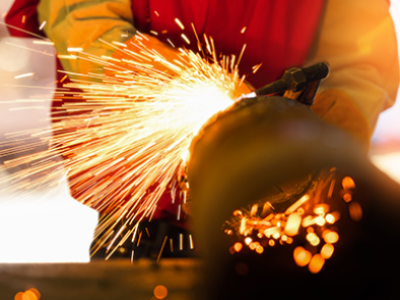
Difference Between Acetylene and Propane
What is the Difference Between Acetylene and Propane Cutting, Which Cut is More Advantageous?Acetylene and propane gases, which are frequently preferred in cutting, welding, and annealing works together with oxygen as flammable gas, have different advantages and disadvantages when compared to each other. In both of them, it is important to use the right equipment in order to get healthy results in terms of quality, cost, and efficiency.Before scrutinizing acetylene and propane gases in comparison with their results such as quality, cost, performance, it is necessary to briefly provide information about questions such as what acetylene gas is, what propane gas is, what is it for, what are the areas of use.Although acetylene (C₂H₂) is a triple bond carrying hydrocarbon, it is not toxic but acts as an asphyxiant at high concentrations. It is a very flammable and combustible gas. It is used in cutting and welding works. Acetylene is passed through hot copper pipes and a substance called benzene is obtained. Benzene is used as a raw material in the production of many organic substances. It is also widely used in the production of plastics in the chemical industry.Propane (C3H8) is a colorless gas composed of carbon and hydrogen. It is used as a flammable gas in welding and cutting works as in acetylene gas. Liquid petroleum gas (LPG) contains lots of propane. In industry and our daily life, it is also used as a fuel in forklifts and many buses, as a tube in homes, in kitchens, and in generators to provide electricity.Cutting processWhen the flame temperatures are compared, we see that the oxy-acetylene flame reaches higher temperature values than the oxy-propane flame.Oxy-Acetylene:3100°COxy-Propane: 2800°CNevertheless, when the two mixture gases are examined as heating value, the fact that the heating value of the flame formed by oxy-propane gas is higher attracts attention.Oxy-Propane: 95,758 KJ/m³Oxy-Acetylene: 54,772 KJ/m³The higher flame temperature of oxy-acetylene is not sufficient for it to be preferred over oxy-propane alone. The high focused heat release capacity of oxy-acetylene gas allows it to cut holes faster. Cutting thin sheets can be made more practically with oxy-acetylene.Higher heating value of propane gas provides an advantage in cutting thick-sectioned parts. The area under the influence of heat is narrower than the cutting process with oxy-acetylene. The fact that the flame focus is lower than the acetylene gas reduces the risk of wearing off the edges by melting during cutting. Edge cutting quality is higher than oxy-acetylene. Oxy-propane gas is often preferred particularly in shipyards where thick-section parts are used.Welding ProcessOxy-propane is not preferred much in oxy-gas welding. The structure of the oxy-acetylene flame allows welding to be performed by cleaning the surface of the material to be welded and creating a suitable shielding gas. Oxy-propane gas can be used in a soldering process. However, the use of oxy-acetylene gas generally gives better quality results in a soldering process.Annealing ProcessWhile acetylene gas creates a hotter flame, the fact that the propane gas creates a flame at a higher temperature as a result of its high calorific value, and the use of oxy-propane is preferred as it increases the annealing efficiency.Acetylene and Propane Cost DifferencesThe amount of oxygen needed by propane gas to react with oxygen gas to form a flame is higher than that of acetylene. While 1 liter of acetylene gas can react with approximately 1 liter of oxygen gas, 1 liter of propane gas reacts with approximately 4 liters of oxygen gas and creates a flame. Hence, the oxygen gas consumption is about 4 times higher when propane is used.The cost of propane gas is lower than acetylene gas. As the usage cost of which gas is more advantageous may vary depending on the place and purpose of use, the practical calculation of gas consumption in the production processes will give the most accurate result. However, the use of oxy-propane gas generally brings along lower costs.SafetySince acetylene gas is an unstable and unbalanced gas, it is suitable for being separated into its components. Therefore, when it is compressed with a pressure of more than 2.5 atmospheres in the free state and its temperature increases, the carbon and hydrogen in its composition start to decompose. At the same time, it explodes by increasing its pressure 11 times without ignition and combustion. As a result, pressures higher than 1.5 atmospheres are not permitted in acetylene production devices.The result of this situation should not be perceived to mean that propane gas is a safer gas than acetylene. While acetylene gas is lighter than air, as a result of the fact that propane gas's specific gravity is heavier than air, any propane leak in a confined space can precipitate onto the floor and cause poisoning. If propane gas does not receive enough oxygen while reacting with oxygen gas, incomplete combustion may occur, giving carbon monoxide to the environment and posing a risk of poisoning.Both gases become flammable and explosive as a result of their compounds with air and oxygen at certain rates. Flame check valves must be used for work safety.In both methods of cutting acetylene and propane, it is important to use the right equipment to obtain healthy results in terms of quality, cost, and efficiency. To examine our products in detail, you can review the Gekamac Gas Fixtures product page.
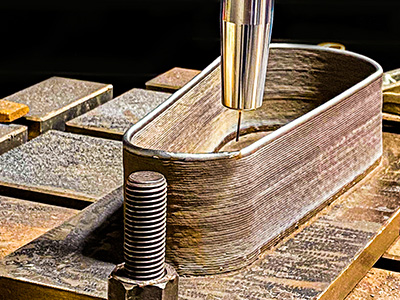
What is Additive Manufacturing (WAAM)
Elements such as a clean environment, low cost, speed in production and raw material savings have led to the emergence of the method in the industry under the names "3D-Printing" or "Additive Manufacturing." Additive manufacturing is based on the principle of creating (mainly using welding technology) a geometric structure by stacking the raw material in the form of layers without removing machining, as opposed to traditional machining methods."Wire Arc Additive Manufacturing - WAAM," which is one of the additive manufacturing methods, is the most suitable additive manufacturing method for low production costs, high deposition rates, and the production of fast and large parts. The name WAAM is given to the production of parts with robotic welding technology according to the 3D drawing of the part to be produced using welding wire. In our content, the details of the question of what is additive manufacturing, which is one of the topics that are a matter of curiosity in the sector, are included.Other additive manufacturing methods generally use metal powder instead of welding wire, and laser beam or electron beam as arc welding. Since there is still no strong metal powder production technology in our country, additive production using powder has to be entirely dependent on abroad. Another disadvantage of these powders imported from abroad is that they have high cost.Advantages of Additive Manufacturing (WAAM)Unlike traditional subtractive methods, the WAAM method is based on a layer-by-layer part production approach. Thanks to this, the material is collected only in the required dimensions and close to its final shape, and the material is saved. With the WAAM method, metallic parts can be produced on a larger scale than powder-based additive manufacturing methods. As the robot arm used in the process has more mobility as it can reach, it allows the production of large and complex parts that cannot be produced by powder-based methods.The WAAM process is a method that also allows for personalized production. It reduces production investment costs for manufacturers with a varying product range. It also provides cost savings in mold design and workmanship as no special gauge/mold tools are needed during the production phase. It provides efficiency by reducing labor and time. Because it is also used in repair maintenance and repair works, it also makes it possible to manufacture spare parts fast. The welding wire used as a feed material in the WAAM process is cheaper and has higher accessibility than the metal powders used in powder-based methods. As the WAAM process is a resource-based method, it consists of cheaper and ready-made equipment compared to other methods. The surface treatments in the WAAM process are relatively less compared to other additive manufacturing methods, and it enables the production of the parts desired to be produced with the closest versions to their final state.Uses of Additive ManufacturingAdditive manufacturing method can be used in many fields, particularly in aviation and space, automotive, maritime, oil & gas, and renewable energy sectors.Innovative ApplicationsIstanbul Gedik University Welding Technology Application and Research Center and Gedik Welding R&D Center conduct joint R&D studies on innovative applications of WAAM Technology. Dr. Uğur Gürol, Welding Technology Application & Research Center and Gedik Test Center Manager, says that this knowledge of Gedik Welding, which can develop and produce welding wires with different characteristics used in WAAM Technology in accordance with WAAM and apply them with a robotic system, has a strategic importance for the technology in question.Gürol said, “The welding wire (as solid or cored wire) required for WAAM is made suitable for this technology by making the necessary improvements. The GeKa WAAM Product Catalogue and system will be presented to the market at the SCHWEISSES & SCHNEIDEN Fair to be held in Germany soon.”Within the scope of WAAM projects carried out in partnership with Gedik Welding R&D Center and Istanbul Gedik University with this purpose, the first parts have been produced successfully by using solid and cored welding wires and a welding robot. At the same time, he stated that these studies are supported by national and international projects.Future TargesThe R&D studies conducted at Gedik Kaynak R&D Center are aimed at producing this technology with the welding technology of “Bi-Material;” that is, complex parts containing more than one material. The additive manufacturing method carried out using two different materials in the future manufacturing sector is particularly important for the defense industry. In this field, it was aimed to create a product by using two different materials (for example, low alloy welding wire and stainless welding wire) in the additive manufacturing method in the Gedik Kaynak R&D center, and the results of the studies were turned into scientific articles and published in "The International Congress on 3D Printing (Additive Manufacturing) Technologies and Digital Industry” (3D-PTC2021).
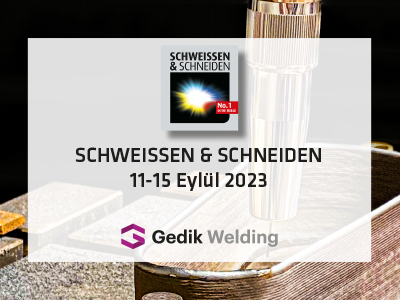
We are participating in the SCHWEISSES & SCHNEIDEN Fair
The Schweissen & Schneiden trade fair, the undisputed number one event in the welding and cutting industry, will bring together all experts in joining, cutting, and surface treatment technologies at the Messe Essen exhibition grounds.